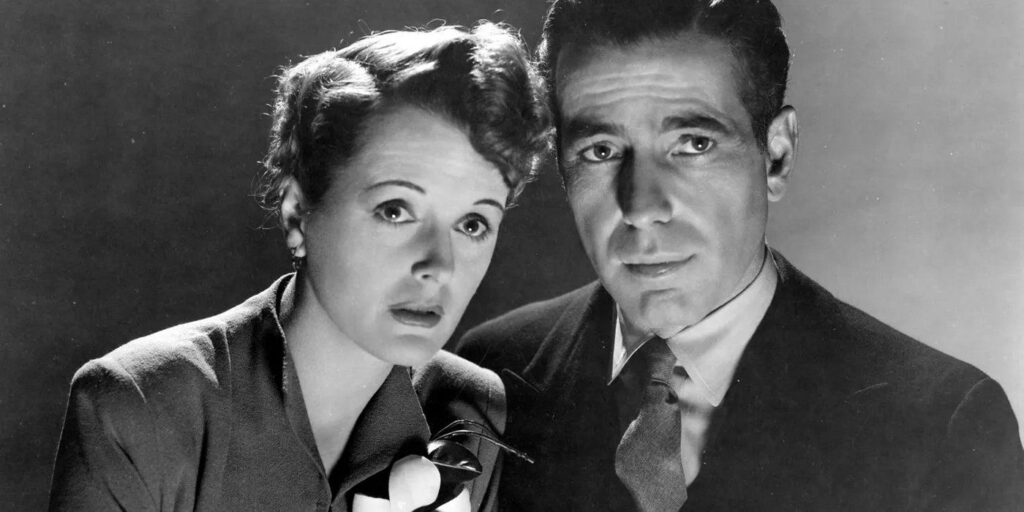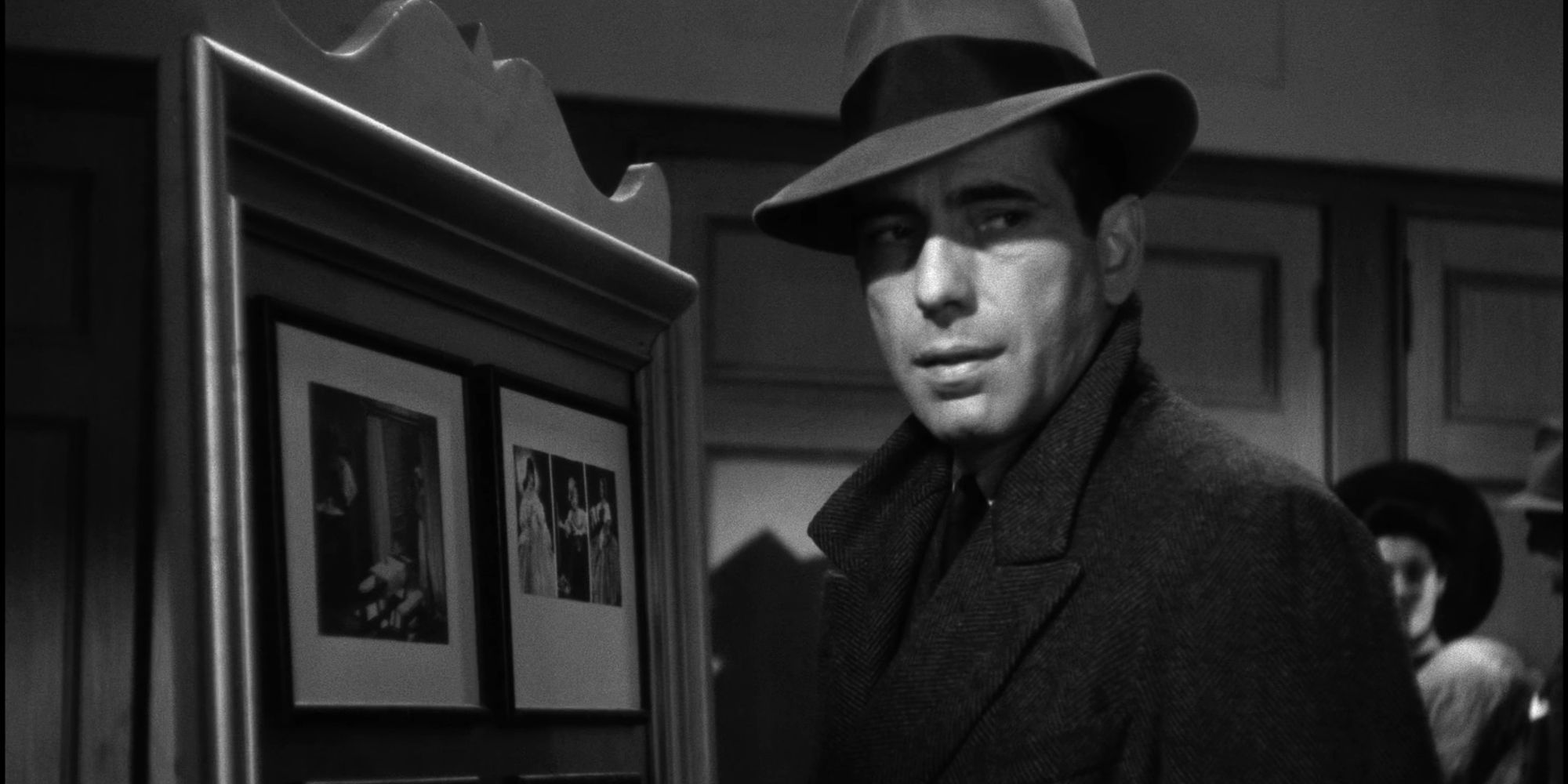Film noir was one of the most popular movie genres in the 1940s and 1950s, and some of the most important films in this genre remain known as masterpieces to this day. The genre drew on German expressionist filmmaking techniques to tell stories in the hard-boiled detective and thriller genres, thrilling fans looking for great mysteries.
The films owed a great deal to the pulp novels of the era, with authors like Raymond Chandler (The Big Sleep) and Dashiell Hammett (The Maltese Falcon) not only influencing the movies but also having their stories adapted into film noir classics. The original film noir also gave rise to neo-noirs, such as Chinatown, which is a different genre.
10
Out Of The Past (1947)
Out of the Past stars Robert Mitchum as Jeff Bailey, a gas station owner in a small town. However, what no one knows is that he was a former private investigator who left his life behind after he double-crossed a former employer. Soon, the man he betrayed finds out he is there and shows up demanding retribution.
Jeff Bailey has to leave his happy life behind and return to the seedy jobs that he had left behind in his past. When reviewing the movie, Robert Ebert called it the best film noir of its era, and that was high praise. While not a PI being hired, Robert Mitchum plays Bailey in the same mold as Sam Spade and Philip Marlowe to great effect.
The Library of Congress also praised the film by adding it to the National Film Registry in 1991 for its historical and cultural significance.
9
The Postman Always Rings Twice (1946)
One of the most prominent themes in film noir involves a femme fatale convincing a man to do something terrible for her sake, often with ulterior motives and no intention of remaining loyal in the end. That happens in The Postman Always Rings Twice, where Lana Turner plays a woman named Cora Smith who plans her husband’s murder.
John Gardner plays the man who Cora finds to help her kill her husband, and when his character, Frank Chambers, gets involved, he has no way out, and his fate is sealed. This movie is one of the film noir classics that takes viewers into the seedy underworld of crime, revealing that nothing is ever as it seems.
This was the third time the novel of the same name had been adapted, but the first time the title had been used. It also shared some of the exact dialogue from James Cain’s novel, and it remains a masterclass in film noir filmmaking.
8
Touch Of Evil (1958)
Orson Welles created some remarkable films throughout his career, with Citizen Kane widely regarded as one of the greatest in film history. However, his film noir Touch of Evil is just as deserving of praise. The movie opens with an extended scene where a recently married couple walks across the U.S.-Mexico border only to witness a car bombing.
The cast is great, with Welles playing a corrupt police detective who wants to pin the murders on someone else, alongside notable cast members including Charlton Heston, Dennis Weaver, Janet Leigh, and Marlene Dietrich. Critics panned the original movie, but when Welles released his director’s cut, it proved to be a masterpiece.
7
The Asphalt Jungle (1950)
The film noir genre helped pave the way for future crime genres, including the French New Wave and the Neo-Noir movement. While many original film noirs focused on private detectives and betrayals, there was also a group that explored the crime drama of bank robberies and heists. The Asphalt Jungle is the best of these.
John Huston directed The Asphalt Jungle, which stars Sam Jaffe as a criminal mastermind who plans an elaborate robbery the second he is released from prison. With a payout of half a million dollars, he assembles a team to execute the heist, but nothing goes as planned once the scheme begins.
The film noir aspects are perfect here, with both the filmmaking style and the story’s themes, but it also remains a tense thriller and has influenced almost every heist movie that followed.
6
The Big Sleep (1946)
Humphrey Bogart was not only the top hard-boiled detective in the film noir era of moviemaking, but he was also the man who took on the two most famous roles in pulp detective novel history. He played Dashiell Hammett’s Sam Spade and Raymond Chandler’s Philip Marlowe, the latter of which he played in The Big Sleep.
In The Big Sleep, directed by Howard Hawks, Bogart teamed with Lauren Bacall in the movie where they began their real-life relationship. They even made the movie twice, the second time in 1946 after they had been dating for a while, and that is the better version.
Unlike many of the best film noir movies, this one made almost no sense plotwise, but it wasn’t the plot that made this movie great — it was the performances. It was added to the National Film Registry in 1997.
5
The Third Man (1949)
Orson Welles not only directed great movies, but he also starred in a few films for other directors. The best of his acting roles came in the 1949 film noir movie The Third Man. In this film, he plays Harry Lime, a man who invites his close friend, Holly Martins (Joseph Cotten), to visit him in Vienna.
However, when Holly arrives, he learns that Harry Lime died. The only problem is that, before Holly can mourn, he looks out the window and sees Harry standing in the shadows. This leads Holly into a conspiracy where he must figure out why his friend faked his death and decide if he wants to go along with the schemes.
The film is one of the best film noirs in terms of filmmaking style, as it effectively utilizes the dark shadows and askew angles that made German expressionism so distinctive. Often, the film is regarded as one of the best British movies ever made.
4
In A Lonely Place (1950)
While Humphrey Bogart has starred in some great roles as private detectives in film noir movies, he also had one of the most frightening roles of his career in a noir as a suspected murderer. Bogart plays Dixon Steele, a man believed to have killed someone, but whose innocence or guilt has not been proven.
He falls in love with a neighbor named Laurel (Gloria Grahame), an aspiring actress in Hollywood who is still wide-eyed and innocent. However, when she begins to suspect that Dixon might be guilty of the crimes he was accused of, she realizes her life might be in danger.
What elevates this film noir to great heights is the ending, where no one receives a happy ending, even when the truth about Dixon’s role is uncovered. The final line that Laurel says remains one of the best to end a film noir movie.
3
Sunset Boulevard (1950)
Sunset Boulevard is not only one of the best film noir films ever made, but also one of the best movies ever made about Hollywood. The opening scene, which shows someone floating face down in a Hollywood swimming pool, remains one of the most iconic openings in movie history.
Directed by Billy Wilder, Sunset Boulevard is a biting critique of Hollywood, and the story follows a struggling screenwriter named Joe Gillis (William Holden) who narrates the story of how he ended up dead in the swimming pool. It starts when he meets a former silent movie star named Norma Desmond (Gloria Swanson).
The movie was a massive success, nominated for 11 Oscars, including a nomination in all four acting categories, and it won three of them. It remains one of the best films in history and was added to the National Film Registry in 1989 as one of the first ever put onto that list.
2
Double Indemnity (1944)
Directed by Billy Wilder, Double Indemnity has possibly the greatest femme fatale in movie history. While it was easy to see her wanting out of her marriage, the lengths she went to were deplorable. Barbara Stanwyck is Phyllis Dietrichson, a housewife who convinces a hapless guy to kill her husband.
Fred MacMurray plays insurance salesman Walter Neff, the man who Phyllis convinces to kill her husband after she learns about the “double indemnity” in their life insurance policy, which says she will get double the payout if her husband dies in an accidental death that was no fault of their own.
The entire story is one of betrayal and heartbreak, and Wilder was at the top of his game, as was his cast in telling this dark film noir. It picked up seven Oscar nominations, although it didn’t win any.
1
Maltese Falcon (1941)
The Maltese Falcon is based on the 1930 pulp mystery novel by Dashiell Hammett, with Humphrey Bogart starring as private investigator Sam Spade. Mary Astor plays femme fatale Ruth Wonderly, a woman who hires Spade to find her missing sister, who she says ran off with a man named Floyd Thursby.
Quickly, dead bodies start showing up, including fellow PI Miles Archer and Floyd Thursby. When Spade learns that Ruth lied and is really a woman named Brigid O’Shaughnessy, he asks him to find out who killed Thursby. He soon discovers that the entire situation revolves around finding a valuable statuette called the Maltese Falcon.
The movie is full of dark twists and turns that film noirs were known for, and Humphrey Bogart proved he was the perfect hard-boiled detective for this genre. The Library of Congress added it to the National Film Registry in 1989 as one of the first films ever chosen.


